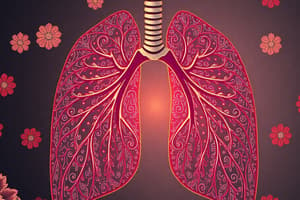Podcast
Questions and Answers
What is the primary function of the human respiratory system?
What is the primary function of the human respiratory system?
- Producing blood cells
- Maintaining body temperature
- Providing carbon dioxide to cells
- Facilitating the exchange of gases (correct)
Where does gas exchange occur in the respiratory system?
Where does gas exchange occur in the respiratory system?
- In the trachea
- At the alveoli-capillary interface (correct)
- At the bronchioles
- At the bronchi
Which structure in the respiratory system moistens and warms incoming air?
Which structure in the respiratory system moistens and warms incoming air?
- Bronchioles
- Trachea (correct)
- Alveoli
- Bronchi
What supports the human respiratory system by studying and applying knowledge to improve respiratory health?
What supports the human respiratory system by studying and applying knowledge to improve respiratory health?
Where are tiny air sacs called alveoli found in the respiratory system?
Where are tiny air sacs called alveoli found in the respiratory system?
What is the function of capillaries in relation to the alveoli in the respiratory system?
What is the function of capillaries in relation to the alveoli in the respiratory system?
What is one of the main tasks performed by biology research assistants in the study of the respiratory system?
What is one of the main tasks performed by biology research assistants in the study of the respiratory system?
Which of the following is NOT a current research topic in respiratory science mentioned in the text?
Which of the following is NOT a current research topic in respiratory science mentioned in the text?
What role do undergraduate research assistants play in respiratory science according to the text?
What role do undergraduate research assistants play in respiratory science according to the text?
Which of the following diseases focuses on understanding the molecular basis according to the text?
Which of the following diseases focuses on understanding the molecular basis according to the text?
What is the main goal of investigating Pulmonary Fibrosis according to the text?
What is the main goal of investigating Pulmonary Fibrosis according to the text?
How do biology research assistants contribute to the field of respiratory science?
How do biology research assistants contribute to the field of respiratory science?
Flashcards are hidden until you start studying
Study Notes
The Respiratory System: Supporting Life's Essential Processes
The human respiratory system is a complex network of organs and tissues that facilitate the exchange of gases—oxygen and carbon dioxide—between the environment and the body's cells. This intricate system is supported by biology research assistants and scientists who study, analyze, and apply knowledge to better understand and improve respiratory health.
Structures of the Respiratory System
Human respiration begins with the nose, which moistens and warms the incoming air. The air then travels down the trachea and into the bronchi, which branch into the bronchioles. Tiny air sacs called alveoli, which are surrounded by tiny blood vessels called capillaries, are found at the end of the bronchioles. At the alveoli-capillary interface, gas exchange occurs between the air and bloodstream.
Functions of the Respiratory System
The primary functions of the respiratory system are:
- Providing oxygen to cells for metabolic processes
- Removing carbon dioxide from cells as waste
- Maintaining acid-base balance in the blood and tissues
Biology Research Assistants in Respiratory Science
Biology research assistants play a crucial role in the study of the respiratory system through various tasks:
- Operating laboratory equipment, such as spectrophotometers, centrifuges, and microscopes
- Performing experiments and analyzing data
- Coordinating with other researchers and external parties
- Preparing research papers and presentations
- Conducting literature searches
- Maintaining laboratory equipment and supplies
The Role of Undergraduate Research Assistants
Undergraduate research assistants contribute to the field by gaining valuable skills and experience through hands-on research opportunities. This process not only improves their critical thinking skills and career goals but also supports the advancement of respiratory science.
Current Research in Respiratory Science
Current research in respiratory science explores various topics, such as:
- Asthma: Understanding the pathophysiology of asthma and developing novel therapies to improve symptom control and quality of life
- Chronic Obstructive Pulmonary Disease (COPD): Investigating the mechanisms underlying COPD and developing new treatments and preventive strategies
- Lung Cancer: Genomic and epigenomic studies to identify novel therapeutic targets and predictive biomarkers for personalized treatment
- Pulmonary Fibrosis: Investigating the molecular mechanisms and developing potential therapeutic strategies for pulmonary fibrosis
- Cystic Fibrosis: Understanding the molecular basis of cystic fibrosis and developing new treatment options to improve patient outcomes
Conclusion
The respiratory system is a vital organ system that plays a critical role in maintaining life. The ongoing research and advancements in this field are supported by biology research assistants who contribute their valuable skills and knowledge to better understand and improve respiratory health. This collaborative effort between researchers, students, and professionals is essential for progressing the field and ensuring a healthier tomorrow.
Studying That Suits You
Use AI to generate personalized quizzes and flashcards to suit your learning preferences.




